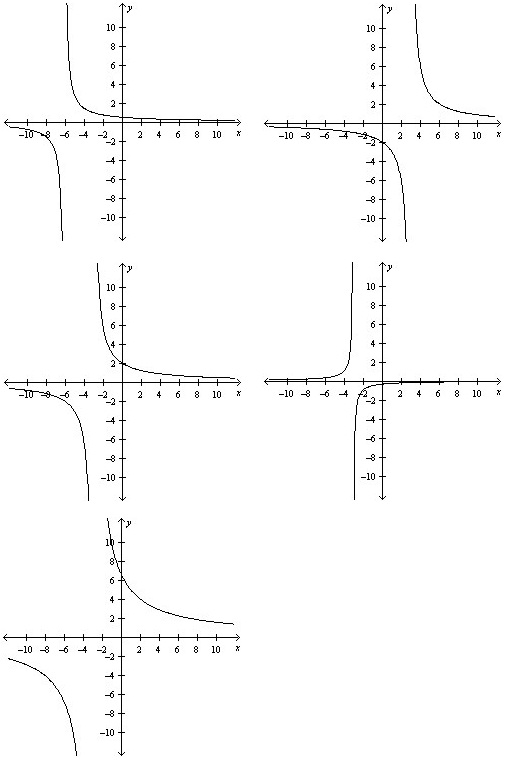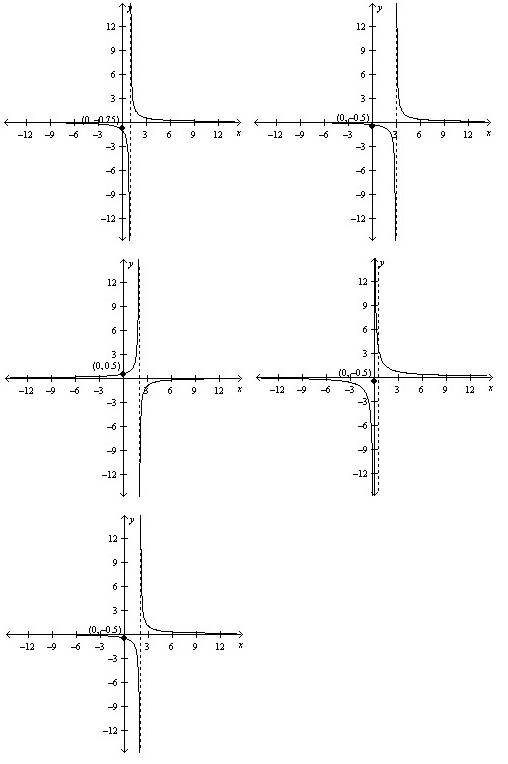Reference no: EM131344301
QUESTION 1
Find the domain of the function f(x) = 8/ (x-6)
Domain: all real numbers x except x=6
Domain: all real numbers x except x=8
Domain: all real numbers x except x = -8
Domain: all real numbers x
Domain: all real numbers x except x = -6
QUESTION 2
Find the domain of the function f(x) = 8x2 / (x2 -49)
Domain: all real numbers x except x = 7
Domain: all real numbers x except x = ±49
Domain: all real numbers x except x = ±8
Domain: all real numbers x except x = -7
Domain: all real numbers x except x = ±7
QUESTION 3
Determine the domains of f and g.
f(x) = (x2 -36) / (x + 6), g(x) = x - 6
Domain of f: all real numbers x except x = -6
Domain of g: all real numbers x
Domain of f: all real numbers x except x = ±6
Domain of g: all real numbers x
Domain of f: all real numbers x except x = ±36
Domain of g: all real numbers x except x=6
Domain of f: all real numbers x except x = 6
Domain of g: all real numbers x
Domain of f: all real numbers x except x = ±6
Domain of g: all real numbers x except x=6
QUESTION 4
Find the domain of f(x) = (x - 9) / (x2 - 81)
all real numbers except x = -9
all real numbers except x = 81
all real numbers except x = 9
all real numbers except x = 9 and x = -9
all real numbers
QUESTION 5
Find the domain of the function and identify any vertical and horizontal asymptotes.
f(x) = (2 +x) / (2 -x)
Domain: all real numbers x except x = 2
Vertical asymptote: x = 2
Horizontal asymptote: y = -1
Domain: all real numbers x
Vertical asymptote: x = -2
Horizontal asymptote: y = 0
Domain: all real numbers x except x = 0
Vertical asymptote: x = 0
Horizontal asymptote: y = -1
Domain: all real numbers x except x = 2
Vertical asymptote: x = 0
Horizontal asympotote: y = -2
Domain: all real numbers x except x = -2
Vertical asympotote: x = 0
Horizontal asympotote: y = 2
QUESTION 6
Find the domain of the function and identify any vertical and horizontal asympototes.
f(x) = 2x2 / (x + 6)
Domain: all real numbers x except x = 0
Vertical asympotote: x = 0
Horizontal asympotote: y = -2
Domain: all real numbers x except x = -6
Vertical asympotote: x = -6
Horizontal asympotote: No horizontal asymptote
Domain: all real numbers x except x = 6
Vertical asympotote: x = 6
Horizontal asympotote: No horizontal asympotote
Domain: all real numbers x except x = 6
Vertical asympotote: x = 6
Horizontal asymptote: y = 2
Domain: all real numbers x
Vertical asymptote: x = -6
Horizontal asymptote: y = 0
QUESTION 7
Find the domain of the function and identify any vertical and horizontal asympototes.
f(x) = (9x2 + 8) / (9x2 + x + 9)
Domain: all real numbers x
Vertical asympotote: No vertical asymptote
Horizontal asymptote: y = 9
Domain: all real numbers x except x = 0
Vertical asymptote: x = 0
Horizontal asymptote: y = -8
Domain: all real numbers x
Vertical asymptote: x = -9
Horizontal asymptote: y = 0
Domain: all real numbers x except x = 9
Vertical asymptote: No vertical asymptote
Horizontal asymptote: No horizontal asymptote
Domain: all real numbers x except x = 9
Vertical asymptote: x = 9
Horizontal asymptote: y = 8
QUESTION 8
Determine the value that the function f approaches as the magnitude of x increases.
f(x) = (2x - 1) / (x - 3)
∞
-3
2
-1
0
QUESTION 9
Simplify f and find any vertical asymptotes of f.
f(x) = (x2 - 36) / (x + 6)
x+6; Vertical asymptote: none
x-6; Vertical asymptote: x=6
x-6; Vertical asymptote: none
x-36; Vertical asymptote: x=6
x-36; Vertical asymptote: none
QUESTION 10
Simplify f and find any vertical asymptotes of f.
f(x) = [x2 (x + 3)] / (x2 + 3x)
x+3; Vertical asymptote: x = -3
x; Vertical asymptote: none
x; Vertical asymptote; x = -3
x - 3; Vertical asympotote: none
x2; Vertical asympotote: none
QUESTION 11
Determine the value that the function f approaches as the magnitude of x increases.
f(x) = 4 - (3/x)
3
-3
4
-4
-3.67
QUESTION 12
Find the domain of the function and identify any vertical and horizontal asymptotes.
f(x) = (x + 2) / (x2 - 4)
The domain is all real numbers x except x = ±2. There is a vertical asymptote at x = -2, and a horizontal asymptote at y = 0.
The domain is all real numbers x except x = ±2. There is a vertical asymptote at x = -4, and a horizontal asymptote at y = 0.
The domain is all real numbers x except x = ±4. There is a vertical asymptote at x = -4, and a horizontal asymptote at y = 0.
The domain is all real numbers x except x = ±2. There is a vertical asymptote at x = 2, and a horizontal asymptote at y = 0.
The domain is all real numbers x except x = ±4. There is a vertical asymptote at x = -2, and a horizontal asymptote at y = 0.
QUESTION 13
Determine the equations of any horizontal and vertical asymptotes of
f(x) = (x2 - 1) / (x2 + 4x -5)
horizontal: y = 5; vertical: x = 0
horizontal: y = 1; vertical: x = -5
horizontal: y=1; vertical: x=1 and x = -5
horizontal: y = -1; vertical: x = -5
horizontal: y = 0; vertical: none
QUESTION 14
Determine the equations of the vertical and horizontal asymptotes of the graph of the function.
f(x) = 2x2 / (x2 - 9)
horizontal: x = -2; vertical: y = 3 and y = -3
horizontal: y = 2; vertical: x = 3 and x = -3
horizontal: y = -3; vertical: x = 2
horizontal: y = 2; vertical: x = 3
horizontal: x = 3 and x = -3; vertical: y = -2
QUESTION 15
Simplify f and find any vertical asymptotes of f.
f(x) = (6x - 1) / (6x2 - x)
x2; Vertical asymptote: x = 0
x-1: Vertical asymptote: none
x: Vertical asymptote: x=0
x:Vertical asymptote: none
1/x: Vertical asymptote: x=0
QUESTION 16
Identify all intercepts of the function.
f(x) = 1 / (x - 4)
y-intercept: (0,-1/4)
y-intercept: (0,1/4)
y-intercept: (0,4)
y-intercept: (4,0)
y-intercept: (0,-4)
QUESTION 17
Identify all intercepts of the following function:
g(x) = (x2 +3) / x
x-intercepts: (±3,0)
no intercepts
x-intercepts: (-3,0)
x-intercepts: (0,0)
x-intercepts: (3,0)
QUESTION 18
Select the correct graph of the function
f(x) = 6 / (x + 3)

QUESTION 19
Select the graph of the rational function. (Plotted additional solution points as needed.)
g(x) = 1 / (2 -x)

QUESTION 20
The cost C (in millions of dollars) of removing p% of the industrial and municipal pollutants discharged into a river is given by
C = 245p / (100 -p), 0 ≤ p < 100
According to this model, would it be possible to remove 100% of the pollutants?
No. The function is undefined at P = 100.
Yes